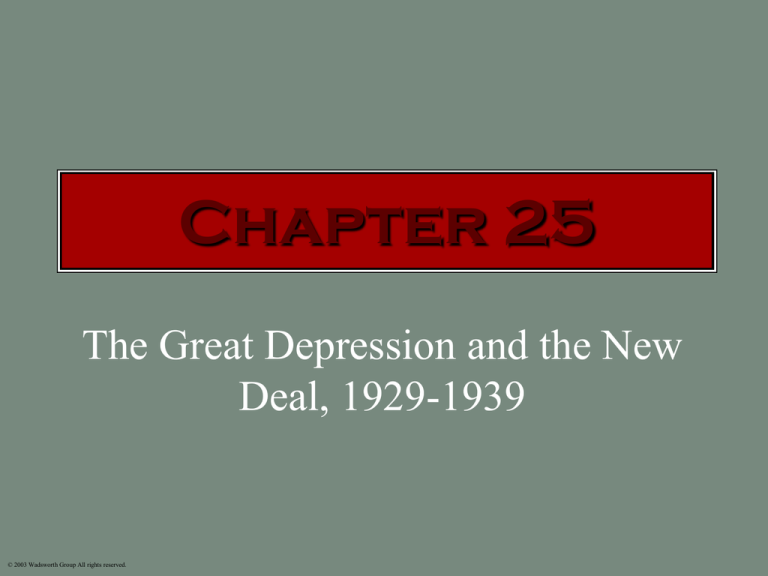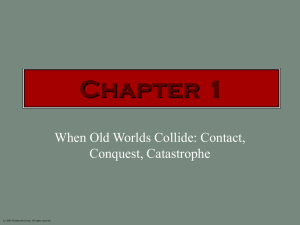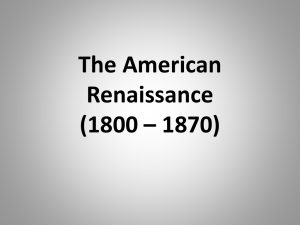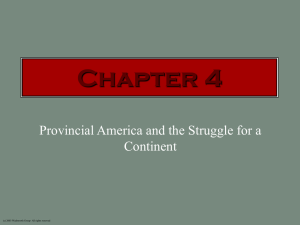
Chapter 25
The Great Depression and the New
Deal, 1929-1939
© 2003 Wadsworth Group All rights reserved.
Causes of the Great Depression
•
•
•
•
Stock Market Speculation
Mistakes by the Federal Reserve Board
An Ill-Advised Tariff
A Maldistribution of Wealth
Stock Market Speculation
• Money poured into the stock market
• Many investors bought on 10% “margin”
– Investor put in only 10% and borrowed from
banks, brokers
– Rampant speculation and risky ventures
• Confidence in future earnings fell and
banks, brokers demanded loan repayment
(c) 2003 Wadsworth Group All rights reserved
Mistakes by the Federal Reserve
Board
• 1930-1931, Federal Reserve curtailed the
amount of money in circulation and raised
interest rates
– Credit became more difficult for the public to
obtain
– Policy was disastrous when the crash occurred
– U.S. needed easier credit once Depression
began
(c) 2003 Wadsworth Group All rights reserved
An Ill-Advised Tariff
• Hawley-Smoot Tariff (1930)
– Raised tariffs on agricultural and manufactured
goods
– Other countries retaliate by raising tariffs on
American goods
(c) 2003 Wadsworth Group All rights reserved
A Maldistribution of Wealth
• Huge gap between wealthy and poor
– Wealthiest families’ incomes rose the most
• Coolidge Administration mistakes:
– Lowered taxes on the wealthy
– Slowed consumer consumption
(c) 2003 Wadsworth Group All rights reserved
Income Distribution
Before the Great
Depression
(c) 2003 Wadsworth Group All rights reserved
Hoover: The Fall of a Self-made
Man
• Despite personal obstacles, Hoover had
determined ambition
• Worked his way up the corporate ranks
• Secretary of Commerce
• President, 1929
• Predicted economic prosperity
(c) 2003 Wadsworth Group All rights reserved
Hoover’s Program
•
•
•
•
Associationalism
Glass-Steagall Act (1932)
Reconstruction Finance Corporation (RFC)
Hoover uncomfortable with deficit spending,
Especially spending that directly gave money to
the poor
– Livestock feed over food for farm families
– Bank bail out over salaries for teachers and city
workers
(c) 2003 Wadsworth Group All rights reserved
The Bonus Army
• Bonus Expeditionary Force
– 20,000 staged a march on Washington, D.C.
•
•
•
•
Anacostia Flats
House agrees, Senate refuses
Douglas MacArthur and George Patton
Election of 1932
– Franklin D. Roosevelt
– Herbert Hoover
(c) 2003 Wadsworth Group All rights reserved
A Culture in Crisis
• Edmund Wilson
• James T. Farrell and the Studs Lonigan
trilogy
• Fugitive from a Chain Gang: 1931 Oscar
• Gangster films
• Marx brothers
– Duck Soup
The Democratic Roosevelt
• Renews hope from the despair of Hoover
years
(c) 2003 Wadsworth Group All rights reserved
An Early Life of Privilege
• Rich New York elite
• Best prep schools and Ivy League
• Until 1920s, success because of family
connections
• Polio
• Eleanor Roosevelt
(c) 2003 Wadsworth Group All rights reserved
Roosevelt Liberalism
• Governor of New York
– 1929-33
– Reform-minded
– Championed liberalism
• Democratic party divisions
– Agrarians vs. Ethnics
– Roosevelt chooses intervention in economic affairs,
libertarian on issues of personal behavior
• “a New Deal for the American people”
(c) 2003 Wadsworth Group All rights reserved
The First New Deal, 1933-1935
• “Hundred Days”
– 15 major pieces of legislation passed
• “Fireside chats”
• Roosevelt exuded confidence and a
defiantly cheery nature
• Had to struggle to a divided party together
and establish a strong government in a
country long opposed to it
(c) 2003 Wadsworth Group All rights reserved
Saving the Banks
•
•
•
•
“Bank holiday”
Emergency Banking Act (EBA)
Economy Act (EA)
Federal Deposit Insurance Corporation
(FDIC)
• Securities Act (1933)
• Securities Exchange Act (1934)
(c) 2003 Wadsworth Group All rights reserved
Bank Failures, 1929-1933
(c) 2003 Wadsworth Group All rights reserved
Economic Relief
• Federal Emergency Relief Administration
(1933)
– Harry Hopkins
• Civilian Conservation Corps (CCC)
• Civil Works Administration (CWA)
• Homeowners’ Loan Corporation
(c) 2003 Wadsworth Group All rights reserved
Repairing the Economy:
Agriculture
• Agricultural Adjustment Act (AAA)
– Recovery by curtailing production
– Doesn’t help tenant farmers
•
•
•
•
"Dust Bowl"
Soil Conservation Service (SCS)
“Okies”
Soil Conservation and Domestic Allotment
Act
(c) 2003 Wadsworth Group All rights reserved
Industrial Reform
• National Recovery Administration (NRA)
– Hugh Johnson
• Publicity and propaganda campaigns
• NRA Codes for steel, textiles, coal mining,
rubber, garment and other manufacturers
– Economy plunged again
– NRA failed overall
– Declared unconstitutional in 1935
(c) 2003 Wadsworth Group All rights reserved
Rebuilding the Nation’s
Infrastructure
• Public Works Administration (PWA)
• $3.3 million budget to sponsor internal
improvements on infrastructure
– Roads, bridges, sewage systems, airport,
hospitals, schools
– 3 major dams in the West
• Grand Coulee, Boulder, Bonneville
(c) 2003 Wadsworth Group All rights reserved
The TVA Alternative
• Tennessee Valley Authority (TVA) 1933
• Government, rather than private corporations,
promoted economic development in Tennessee
Valley Region
–
–
–
–
Established 20 dams in the region
Hydroelectric generators – produced electricity
Reduced floods
Improved agricultural techniques
• New Deal rejects TVA government planning
model for established industry
(c) 2003 Wadsworth Group All rights reserved
david price:
The New Deal and Western
Development
• West benefited most from New Deal
• Bureau of Reclamation
• Boulder Dam (Hoover Dam), Colorado
River
• Grand Coulee Dam, Columbia River, WA
• Bonneville Dam, Columbia River, WA
(c) 2003 Wadsworth Group All rights reserved
Political Mobilization, Political
Unrest, 1934-1935
• Political forces set in motion by New Dealers
• People of United States believed that ordinary
Americans could make a difference
• If Roosevelt can’t bring recovery, people will
find someone who can
(c) 2003 Wadsworth Group All rights reserved
Populist Critics of the New Deal
• Huey P. Long, Louisiana Senator
– Share the Wealth clubs
– Assassinated in 1935
• Father Charles Coughlin “radio priest”
– National Union of Social Justice
– “dictate to preserve democracy”
– Anti-Semitism
• Francis E. Townsend
– Senior citizen program
– Precursor to Social Security
(c) 2003 Wadsworth Group All rights reserved
Labor’s Rebirth
• Clause 7(a) of the NIRA
– Gave workers the right to join labor unions
– Often violated by management
• Strikes and violence
(c) 2003 Wadsworth Group All rights reserved
Anger at the Polls
• Democrats increased their majority in the
House and in the Senate
• Greatest number of “radicals” sent to
Washington
–
–
–
–
Tom Amlie, Wisconsin
Ernest Lundeen, Minnesota
Maury Maverick, Texas
Vito Marcantonio, New York
(c) 2003 Wadsworth Group All rights reserved
The Rise of Radical Third Parties
•
•
•
•
•
Wisconsin Progressive Party
Minnesota Farmer-Labor Party
Commonwealth Builders in Washington
Upton Sinclair and EPIC
Communist Party
– Popular Front against Fascism
(c) 2003 Wadsworth Group All rights reserved
The Second New Deal, 19351937
• Labor unrest of 1934 took Roosevelt by
surprise
• Roosevelt called for new programs to aid
the poor and downtrodden
• Not a socialist, but Roosevelt sought
approval from poor Americans so they
would not turn to radical solutions
(c) 2003 Wadsworth Group All rights reserved
Philosophical Underpinnings
• Underconsumptionism
• Recovery from consumer expenditure not
restricting production
• Keynesianism
– John Maynard Keynes
– Governmental borrowing as a crucial antidepression method
(c) 2003 Wadsworth Group All rights reserved
Legislation of the Second New
Deal
• Social Security Act (1935)
• National Labor Relations Act (1935)
– Robert Wagner
•
•
•
•
Holding Company Act
Wealth Tax Act
Rural Electrification Administration
Works Progress Administration (WPA)
(c) 2003 Wadsworth Group All rights reserved
Victory in 1936: The New
Democratic Coalition
• Alf Landon (Kansas)
– Republican candidate for Presidency
• Roosevelt won landslide victory
• Democrats won reputation as a party of
reform in 1936 elections
– “forgotten Americans”
– African-Americans desert Republicans
(c) 2003 Wadsworth Group All rights reserved
Voter Participation
in Presidential
Elections,
1920-1940
(c) 2003 Wadsworth Group All rights reserved
Rhetoric versus Reality
• 1935-36: Roosevelt’s rhetoric was more radical
than the laws he supported
• He promised more than he delivered to many of
nation’s poor:
– Farm workers, African Americans and Chicanos not
covered by New Deal
• Roosevelt’s corporate ties
• Democratic reality: party of the masses and 1
section of big business
(c) 2003 Wadsworth Group All rights reserved
Growth in Federal
Civilian
Employment,
1920-1940
(c) 2003 Wadsworth Group All rights reserved
Men, Women, and Reform
•
•
•
•
•
•
•
Farm Security Administration (FSA)
Child labor, minimum wage/maximum hours laws
Low cost public housing
New Dealers are technocrats
Frances Perkins
New Deal does not advance women’s rights
Depression turns many men against women in the
work force
• Superman vs. Lois Lane
• Woman of the Year
(c) 2003 Wadsworth Group All rights reserved
Labor in Politics and Culture
• Congress of Industrial Organizations (CIO)
– John L. Lewis and Sidney Hillman
– Labor movement pro-Roosevelt
• United Auto Workers
– General Motors "sit down" strike
• Cultural celebration of the common man
– Frank Capra Mr. Smith goes to Washington
– John Steinbeck The Grapes of Wrath
– Woody Guthrie “This land is your land”
(c) 2003 Wadsworth Group All rights reserved
Labor Union Membership, 1933-1945
(c) 2003 Wadsworth Group All rights reserved
America’s Minorities and the
New Deal
• New Deal gains were distributed unevenly
among America’s poor
• Eastern and southern European ethnics
benefited the most
• African and Mexican-Americans benefited
the least
(c) 2003 Wadsworth Group All rights reserved
Eastern and Southern European
Ethnics
• By 1930s these groups mobilized into a
powerful voice within the Democratic party
• Roosevelt ensured that New Deal monies
reached urban areas where most European
ethnics lived
• Southern and Eastern European ethnics
benefited from their strong working-class
presence and labor organizations
(c) 2003 Wadsworth Group All rights reserved
African Americans
• New Deal reproduced patterns of racial
discrimination
• Blacks living in rural South were still barred
from voting, sharecroppers excluded from
farming programs, denied protection in
farming unions
• Eleanor Roosevelt and Marian Anderson
• Roosevelt’s “Black Cabinet”
(c) 2003 Wadsworth Group All rights reserved
Mexican Americans
• Hoover’s repatriation plan
• Local governments pressured many
Mexicans to leave
• Discrimination against Mexican-Americans
• Many who stayed in the U.S. became the
“invisible minority”
• Many urban-dwelling Mexicans did benefit
from New Deal policies
(c) 2003 Wadsworth Group All rights reserved
American Indians
• Dawes Act
• Bureau of Indian Affairs and Assimilation
pressure
• John Collier
• Johnson-O’Malley Act (1934)
• Indian Reorganization Act (1934)
– Wheeler-Howard Act
(c) 2003 Wadsworth Group All rights reserved
The New Deal Abroad
• Recognition of the Soviet Union
• "Good Neighbors Policy“
• Reciprocal Trade Agreement (1934)
(c) 2003 Wadsworth Group All rights reserved
Stalemate, 1937-1940
• By 1937-38, New Deal lost momentum
– Emerging split between working-class and
middle-class Democrats
– Labor’s growing power vs. middle-class
(c) 2003 Wadsworth Group All rights reserved
The Court Packing Fiasco
• “Court packing" proposal (1937)
– Alienates especially middle class supporters of
the New Deal
• Owen J. Roberts
(c) 2003 Wadsworth Group All rights reserved
The Recession of 1937-1938
• Roosevelt believed the depression was easing
– Scaled back relief programs
– Social Security program went into effect, but without
paying out any pensions until 1941
• Money was not returned to circulation
– Stock market crashed again
• 1938 election more conservative Congress
– Couldn’t repeal existing New Deal
– Did block passage of more New Deal programs
(c) 2003 Wadsworth Group All rights reserved
Unemployment in the Nonfarm Labor Force, 1929-1945
(c) 2003 Wadsworth Group All rights reserved
Federal Expenditures
and Surpluses/Deficits,
1929-1945
(c) 2003 Wadsworth Group All rights reserved
Conclusion
• New Deal strengthens democracy
• Gives previously marginalized groups belief in
political activism
• Keynesian ideas of New Deal reforms vindicated
by World War II
• War solidified political reforms of the 1930s
– Government’s increased role in regulating the economy
and citizens’ social welfare
– State support of unionization, agricultural subsidies,
progressive tax policies
– Government power and money used to develop West
and Southwest
(c) 2003 Wadsworth Group All rights reserved









